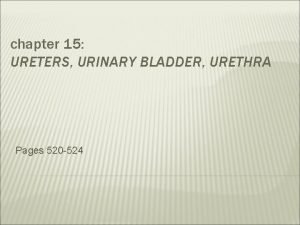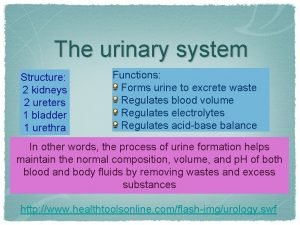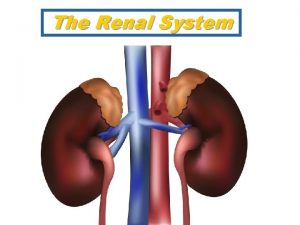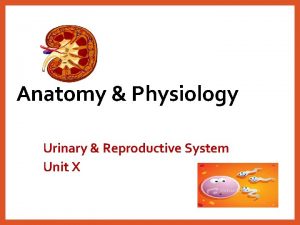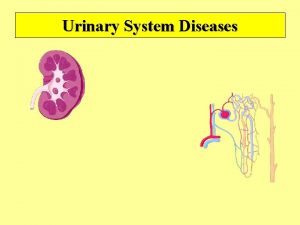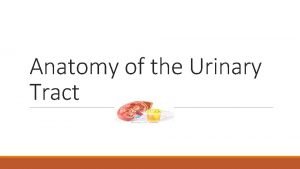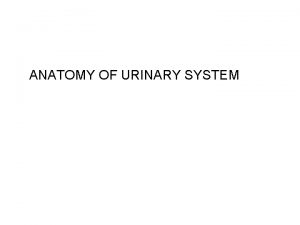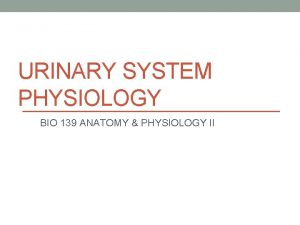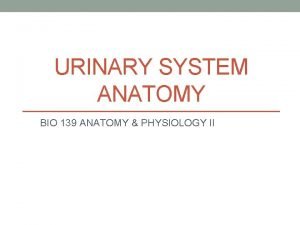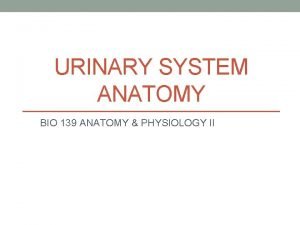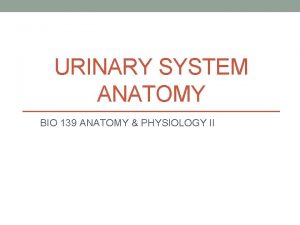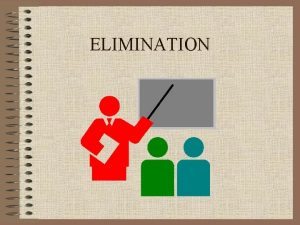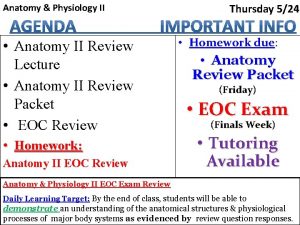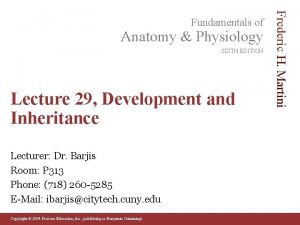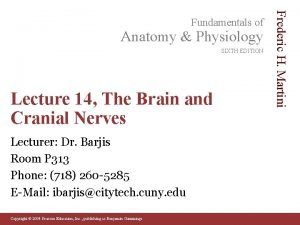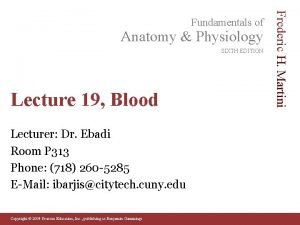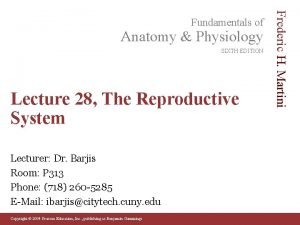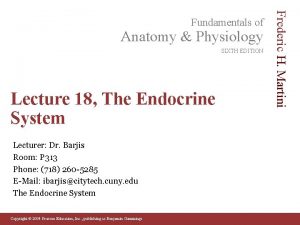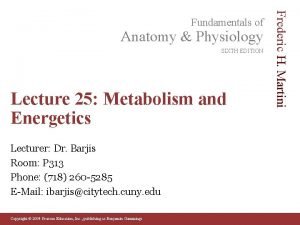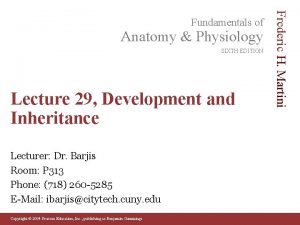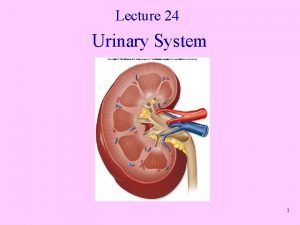Anatomy Physiology SIXTH EDITION Lecture 26 The Urinary































































- Slides: 63

Anatomy & Physiology SIXTH EDITION Lecture 26: The Urinary System Lecturer: Dr. Barjis Room: P 313 Phone: (718) 260 -5285 E-Mail: ibarjis@citytech. cuny. edu Copyright © 2004 Pearson Education, Inc. , publishing as Benjamin Cummings Frederic H. Martini Fundamentals of

Learning Objectives • Identify the components and functions of the urinary system • Describe the location and structural features of the kidneys • Describe the structure of a nephron, and outline the processes involved in the formation of urine • Describe the normal characteristics, composition, and solute concentrations of a representative urine sample

Learning Objectives • List and describe the factors that influence filtration pressure and the rate of filtrate formation • Identify the types of transport mechanisms found along the nephron • Describe how antidiuretic hormone and aldosterone levels influence the volume and concentration of urine

Functions of the urinary system • Functions of the urinary system includes: • 1) Excretion • The removal of organic waste products from body fluids e. g. urea • 2) Elimination • The discharge of waste products into the environment • 3) Homeostatic regulation of blood plasma • Regulating blood volume and pressure • Regulating plasma ion concentrations • Stabilizing blood p. H • Conserving nutrients i. e. preventing nutrient excretion by re-absorption • Detoxification

Urinary system Organs of Urinary system includes: • 1) The kidneys • Produce urine • 2) The ureters • Transport urine from the kidneys to the bladder • 3) The urinary bladder • Stores urine • 4) The urethra • Eliminates urine

An introduction to the Urinary System

The kidneys • Left kidney extends slightly more superiorly than right • Both kidneys and adrenal glands are retroperitoneal • Hilus • Point of entry and exit for renal artery, renal nerves and renal veins and ureter

The Urinary System in Gross Dissection

The Kidneys Sectional anatomy of the kidneys • Kidneys have two layers: An outer cortex and an inner medulla • The medulla consists of 6 -18 conical shaped structures called renal pyramids • The cortex is composed of roughly 1. 25 million nephrons • Major and minor calyces along with the pelvis drain urine to the renal pelvis, and renal pelvis is connected to the ureters

The Structure of the Kidney

Blood supply of the kidneys • Pathway of blood flow to the kidnes: • Renal artery – renal arteries deliver blood to the kidneys • Segmental artery – renal arteries branch to segmental arteries • Interlobar artery - Segmental arteries divide into a series of interlobar arteries • Arcuate artery - interlobar arteries supply blood to the arcuate arteries • Interlobular artery - Each arcuate artery gives rise to a number of interlobular arteries • Afferent arterioles - interlobular artery branch to numer of afferent arterioles • Glomeruli – afferent arteries deliver blood to capillaries called glomeruli. • Glomeruli is network of capilaries found in the corpuscle of nephrone • Renal venules follow similar opposing pattern ending with renal veins

The Blood Supply to the Kidneys

The Blood Supply to the Kidneys

The Nephron • The nephron consists of : • 1) Renal corpuscle – the head of the nephron • The renal corpuscle is composed of Bowman’s capsule and glomeruli • Bowman’s capsule is the cover of the corpuscle that surrounds the glomerulus • the glomerulus is the network of capillaries found inside the corpuscle • Blood arrives at glomerulus by way of an afferent arteriole and departs in an efferent arteriole • 2) Renal tubule – the tubular passageway of the nephron • The renal tubule consists of • Proximal convoluted tubule (PCT) • Loop of Henle • Distal convoluted tubule (DCT)

The Nephron Filtrate is produced at the renal corpuscle of the nephron • In renal corpuscle, blood pressure forces fluid and dissolved solutes out of the glomerular capillaries and into the capsular space. This process is called filtration • Filtration produces an essentially protein-free solution, known as a filtrate • Filtrate is similar to plasma but without proteins i. e. it contains organic substrates (e. g. glucose, fatty acids, amino acids), vitamins, water, electrolytes, waste product and other solutes • Organic substrates, most water, most electrolytes and vitamins are recaptured (re-absorbed) by the renal tubes, before filtrate leaves the kidneys • From the renal corpuscle, filtrate enters the tubular passageway of the nephron

The Nephron • The tubular passageway of the nephron is responsible for: • 1. Reabsorbing organic substrates and vitamins • 2. Reabsorbing water and electrolytes • 3. Secreting waste products • From the tubular passageway of the nephron fluid enters into the collecting system (collecting system are tubes that carry tubular fluid away from the nephron) • Collecting ducts carry he fluid to papillary ducts • Papillary ducts carry the fluid (urine) to the minor calyx • Minor calyx carry the fluid (urine) to major calyx • Number of minor calyces join together to form a major calyx • Major calyx deliver the fluid (urine) to renal pelvis • Renal pelvis is connected to the ureter • Ureter transports the urine to the bladder

Summary of fluid flow from the nephron to the Ureter 1) Renal corpuscle - capsular space. 2) Tubular passageway of the nephron • PCT • Lube of Henle • DCT 3) Collecting duct 4) Papillary ducts 5) Minor calyx 6) Major calyx 7) Renal pelvis 8) Uureter

The Nephron

The Nephron functions include: • 1) Production of filtrate – this occurs at the corpuscle of the nephron • 2) Reabsorption of organic nutrients – this occurs at the tubular passageway of the nephron • 3) Reabsorption of water and ions - this occurs at the tubular passageway of the nephron • 4) Secretion of waste products into tubular fluid - this occurs at the tubular passageway of the nephron

The Nephron There are two types of nephron • 1) Cortical nephrons • ~85% of all nephrons • Located in the cortex • 2) Juxtamedullary nephrons • Closer to renal medulla • Loops of Henle extend deep into renal pyramids

Cortical and Juxtamedullary Nephrons

Cortical and Juxtamedullary Nephrons

Glomerulus anatomy • Podocytes cover lamina densa of capillaries • Project into the capsular space • Pedicels of podocytes separated by filtration slits

The Renal Corpuscle

The Renal Corpuscle

Functional anatomy of the nephron • Tubular passageway of the nephron: • 1) Proximal convoluted tubule (PCT) • Actively reabsorbs nutrients, plasma proteins and ions from filtrate • The PCT reabsorbs 60 -70% of the filtrate produced • Reabsorption of most organic nutrients • Active and passive reabsorption of sodium and other ions • Reabsorption of water • Secretion also occurs in the PCT (this is mostly function of DCT)

Transport Activities at the PCT

Functional anatomy of the nephron • Tubular passageway of the nephron: • 2) Loop of Henle • Descending limb • Ascending limb • Countercurrent multiplication Between ascending and descending limbs of loop • Creates osmotic gradient in medulla • Facilitates reabsorption of water and solutes before the DCT • Permits passive reabsorption of water from tubular fluid

Countercurrent Multiplication and Concentration of Urine

Countercurrent Multiplication and Concentration of Urine

Countercurrent Multiplication and Concentration of Urine

Functional anatomy of the nephron • Tubular passageway of the nephron: • Distal convoluted tubule (DCT) • DCT performs final adjustment of urine • Actively secretes ions, toxins, drugs • Reabsorbs sodium ions from tubular fluid • Tubular cells actively resorb Na+ and Cl- • In exchange for potassium or hydrogen ions (secreted)

Tubular Secretion and Solute Reabsorption at the DCT Animation: Distal Convoluted Tubule (see tutorial)

Tubular Secretion and Solute Reabsorption at the DCT

Urine production maintains homeostasis • Regulating blood volume and composition by excreting or reabsorbing water, sodium, hydroge and other electrolyte • Excreting waste products such as: • Urea • Creatinine • Uric acid

Basic processes of urine formation • 1) Filtration – this is the first process, and it occurs in corpuscle of nephron • Filtration occur because blood pressure forces fluid and dissolved solutes out of the glomerular capillaries and into the capsular space • 2) Reabsorption – this is the second process, and it occurs in tubular passageway of the nephron • One limitation to the filtration process is that the filtrate produced in the corpuscle contain organic substrates, vitamins and other beneficial material. Therefore the second process will reabsorb water and solutes from the filtrate • 3) Secretion – this is the third process and it occurs in the tubular passageway of the nephron • Transport of solutes from the peritubular fluid into the tubular fluid

Filtration and Reabsorption Filtration in the kidneys modified by carrier mediated transport • Facilitated diffusion • Active transport • Countertransport Reabsorption and secretion is accomplished via: • Diffusion, • Osmosis, and • Carrier-mediated transport

Renal function • Most regions of the nephron perform a combination of functions • General functions can be identified • Filtration in the renal corpuscle • Nutrient reabsorption along the PCT • Active secretion at PCT and DCT • Loops of Henle regulate final volume and solute concentration

An Overview of Urine Formation

Filtration pressures - Glomerular filtration • Occurs as fluids move across the glomerulus • In response to glomerular hydrostatic pressure (GHP) and blood pressure in the glomerular capillaries • Capsular hydrostatic pressure (Cs. HP) opposes GHP • Blood colloid osmotic pressure (BCOP) opposes GHP • Net hydrostatic pressure (NHP) = GHP – Cs. HP • Filtration (FP) = NHP – BCOP

Glomerular Filtration

Glomerular Filtration

Glomerular filtration rate (GFR) • GFR is the amount of filtrate produced by the kidneys in one minute • Factors that alter filtration pressure will change the GFR e. g. a drop in pressure will lead to a decrease in GFR

The Response to a Reduction in the GFR • When blood pressure is law, the amount of filtrate in the corpuscle decreases. • Law filtrate stimulates production of renin by juxtaglomerular nephron (apparatus) • • • 1) Renin converts angiotensin to angiotensin I Angiotensin I is activated to angiotensin II Angiotensin II affects the/ or acts on: Blood vessel • 2) Adrenal gland • 3) At the adrenal gland it increases production of aldosterone. Aldosterone increases sodium retention. Higher sodium rentention means higher water retention. Central nervous system • • Angiotensin II stimulates constriction of blood vessels At the central nervous system it stimulates thirst, increases production ADH increases water reabsorption by the collecting system. Note that in the absence of ADH no reabsorption takes place in the collecting system All of the above actions will lead to an increase in the blood pressure

Reabsorption and secretion along the collecting system • Water and solute loss is regulated by aldosterone and ADH • Reabsorption • Sodium ion, bicarbonate, and urea are resorbed • Secretion • p. H is controlled by secretion of hydrogen or bicarbonate ions

The Effects of ADH on the DCT and Collecting Ducts

Function of the vasa recta • Removes solutes and water • Balances solute reabsorption and osmosis in the medulla

Composition of normal urine • Varies with the metabolic and hormonal events of the body • Reflects filtration, absorption and secretion activity of the nephrons • Urinalysis is the chemical and physical analysis of urine

A Summary of Renal Function

A Summary of Renal Function

Urine production ends with fluid entering the renal pelvis • Rest of urinary system transports, stores and eliminates • Ureters • Bladder • Urethra

A Radiographic View of the Urinary System

The ureters and The urinary bladder The ureters • Pair of muscular tubes • Extend from renal pelvis to the bladder • Peristaltic contractions force urine toward the urinary bladder The urinary bladder • Hollow, muscular organ • Reservoir for the storage of urine • Contraction of detrusor muscle voids bladder

Organs for the Collection and storage of Urine

Organs for the Collection and storage of Urine

Organs for the Collection and storage of Urine

The urethra • Extends from the urinary bladder to the exterior of the body • Passes through urogenital diaphragm (external urinary sphincter) • Differs in length and function in males and females

The Histology of the Organs that Collect and Transport Urine

Micturition reflex and urination • Urination coordinated by micturition reflex • Initiated by stretch receptors in wall of bladder • Urination requires coupling micturition reflex with relaxation of external urethral sphincter

The Micturition Reflex

Changes with aging include: • Decline in the number of functional nephrons • Reduction of GFR • Reduced sensitivity to ADH • Problems with the micturition reflex

You should now be familiar with: • The components of the urinary system and their functions • The location and structural features of the kidneys • The structure of a nephron, and the processes involved in the formation of urine • The normal characteristics, composition, and solute concentrations of a representative urine sample

You should now be familiar with: • The factors that influence filtration pressure and the rate of filtrate formation • The types of transport mechanisms found along the nephron • How antidiuretic hormone and aldosterone levels influence the volume and concentration of urine
 Human anatomy and physiology seventh edition marieb
Human anatomy and physiology seventh edition marieb Human anatomy & physiology edition 9
Human anatomy & physiology edition 9 Uterus perimetrium
Uterus perimetrium The sixth sheik's sixth sheep's sick
The sixth sheik's sixth sheep's sick The sixth sick sheik's sixth sheep's sick lyrics
The sixth sick sheik's sixth sheep's sick lyrics Urethra
Urethra What is the name
What is the name Position of kidney in human body picture
Position of kidney in human body picture Biochemistry sixth edition
Biochemistry sixth edition Computer architecture a quantitative approach sixth edition
Computer architecture a quantitative approach sixth edition Automotive technology principles diagnosis and service
Automotive technology principles diagnosis and service Automotive technology sixth edition
Automotive technology sixth edition Citation sample pdf
Citation sample pdf Computer architecture a quantitative approach 6th
Computer architecture a quantitative approach 6th Precalculus sixth edition
Precalculus sixth edition Rational people think at the margin
Rational people think at the margin Computer architecture a quantitative approach sixth edition
Computer architecture a quantitative approach sixth edition Microbial physiology lecture notes
Microbial physiology lecture notes Physiology of sport and exercise 5th edition
Physiology of sport and exercise 5th edition 01:640:244 lecture notes - lecture 15: plat, idah, farad
01:640:244 lecture notes - lecture 15: plat, idah, farad Upper airway anatomy
Upper airway anatomy Tattoo anatomy and physiology
Tattoo anatomy and physiology Science olympiad anatomy and physiology
Science olympiad anatomy and physiology Structure anatomy and physiology in agriculture
Structure anatomy and physiology in agriculture Anatomy and physiology bones
Anatomy and physiology bones Peptic ulcer anatomy and physiology
Peptic ulcer anatomy and physiology Sheep liver lobes
Sheep liver lobes Podbřišek
Podbřišek Wpigastric region
Wpigastric region Rbc anatomy and physiology
Rbc anatomy and physiology Chapter 14 anatomy and physiology
Chapter 14 anatomy and physiology Http://anatomy and physiology
Http://anatomy and physiology Waistline
Waistline Physiology of appendix
Physiology of appendix Aohs foundations of anatomy and physiology 1
Aohs foundations of anatomy and physiology 1 Aohs foundations of anatomy and physiology 1
Aohs foundations of anatomy and physiology 1 Anatomical planes
Anatomical planes Anatomy and physiology chapter 8 special senses
Anatomy and physiology chapter 8 special senses Chapter 13 anatomy and physiology of pregnancy
Chapter 13 anatomy and physiology of pregnancy Unit 26 animal anatomy physiology and nutrition
Unit 26 animal anatomy physiology and nutrition Science olympiad anatomy and physiology 2020 cheat sheet
Science olympiad anatomy and physiology 2020 cheat sheet Anatomy and physiology chapter 2
Anatomy and physiology chapter 2 Stomach anatomy corpus
Stomach anatomy corpus Anatomy and physiology of diabetes
Anatomy and physiology of diabetes Heat and cold
Heat and cold Chapter 14 the digestive system and body metabolism
Chapter 14 the digestive system and body metabolism Chapter 10 blood anatomy and physiology
Chapter 10 blood anatomy and physiology Aohs foundations of anatomy and physiology 1
Aohs foundations of anatomy and physiology 1 Aohs foundations of anatomy and physiology 1
Aohs foundations of anatomy and physiology 1 What produces bile
What produces bile Anatomy and physiology chapter 15
Anatomy and physiology chapter 15 Cornell notes for anatomy and physiology
Cornell notes for anatomy and physiology Necessary life functions anatomy and physiology
Necessary life functions anatomy and physiology Holes anatomy and physiology chapter 1
Holes anatomy and physiology chapter 1 Holes essential of human anatomy and physiology
Holes essential of human anatomy and physiology Anatomy and physiology unit 7 cardiovascular system
Anatomy and physiology unit 7 cardiovascular system Gi tract histology
Gi tract histology Anatomy and physiology
Anatomy and physiology Distal and proximal
Distal and proximal Aohs foundations of anatomy and physiology 1
Aohs foundations of anatomy and physiology 1 Aohs foundations of anatomy and physiology 1
Aohs foundations of anatomy and physiology 1 Chapter 1 an introduction to anatomy and physiology
Chapter 1 an introduction to anatomy and physiology Physiology exam 1
Physiology exam 1 Welcome to anatomy and physiology
Welcome to anatomy and physiology





